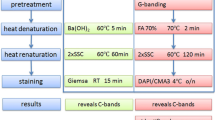Summary
A technique is described for the production of detailed and richly contrasting G-band patterns in human prometaphase chromosomes with the aid of the triphenylmethane dye basic fuchsin. The usefulness of this method is illustrated by its application for the precise analysis of two chromosome 11 rearrangements. It is also demonstrated that high-resolution banding with basic fuchsin can reveal bands not present in the international standard idiogram of human prophase chromosomes (ISCN 1981). The technique described can also be used for easy recognition of the late replicating X chromosome, which stains darker than its early replicating homologue. A preliminary analysis of the late replicating X chromosomes in a 49,XXXXY individual suggests that the three supernumerary X chromosomes do not necessarily replicate synchronously.
Similar content being viewed by others
References
Fraccaro M, Lindsten J, Ford CE, Iselius L (1980) The 11q;22q translocation: a European collaborative analysis of 43 cases. Hum Genet 56:21–51
ISCN (1981) An International System for Human Cytogenetic Nomenclature — High Resolution Banding (1981). Birth Defects, vol XVII, No 5; also, Cytogenet Cell Genet 31:1–23
Ledbetter DH, Riccardi VM, Airhart SD, Strobel RJ, Keenan BS, Crawford JD (1981) Deletions of chromosome 15 as a cause of the Prader-Willi syndrome. N Engl J Med 304:325–329
Scheres JMJC (1977) R- and CT-banding of human chromosomes with basic fuchsin. Histochemistry 52:349–353
Scheres JMJC, Hustinx TWJ, Rutten FJ, Merkx GFM (1977) “Reverse” differential staining of sister chromatids. Exp Cell Res 109:466–468
Scheres JMJC, Merkx GFM (1976) Banding of human chromosomes with basic fuchsin. Hum Genet 32:155–169
Viegas-Pequignot E, Dutrillaux B (1978) Une méthode simple pour obtenir des prophases et des prométaphases. Ann Genet (Paris) 21:122–125
Yunis JJ (1976) High resolution of human chromosomes. Science 191:1268–1270
Yunis JJ (1981a) Mid-prophase human chromosomes. The attainment of 2000 bands. Hum Genet 56:293–298
Yunis JJ (1981b) Chromosomes and cancer: new nomenclature and future directions. Hum Pathol 12:494–503
Yunis JJ, Ramsey NKC (1980) Familial occurrence of the aniridia-Wilms tumor syndrome with deletion 11p13-14.1. J Pediatr 6:1027–1030
Zackai EH, Emanuel BS (1980) Site-specific reciprocal translocation, t(11;2)(q23;q11), in several unrelated families with 3:1 meiotic disjunction. Am J Med Genet 7:507–521
Author information
Authors and Affiliations
Rights and permissions
About this article
Cite this article
Scheres, J.M.J.C., Merkx, G.F.M. & Hustinx, T.W.J. Prometaphase banding of human chromosomes with basic fuchsin. Hum Genet 61, 8–11 (1982). https://doi.org/10.1007/BF00291322
Received:
Issue Date:
DOI: https://doi.org/10.1007/BF00291322




